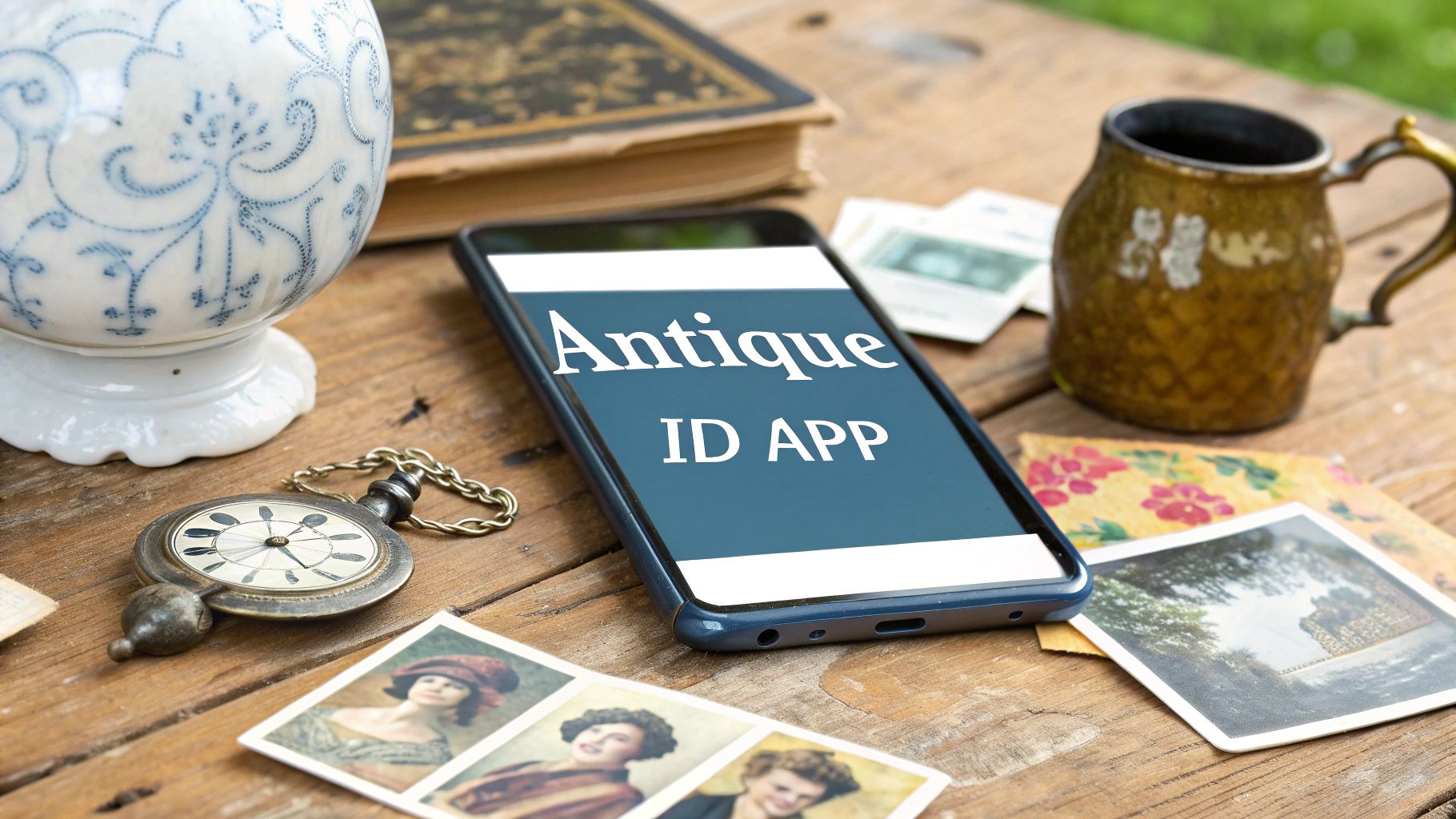Ever found an old, curious object at a flea market or in your grandmother's attic and thought, "I wonder what this is?" That's the exact question an antique identification app is built to answer. Think of it as having a personal antique expert right in your pocket.
These apps use your phone's camera and some pretty smart technology to identify what you've found, give you an idea of its value, and even share a bit of its history.
What Exactly Is an Antique Identification App?
It’s that moment of discovery—holding an object and feeling a jolt of curiosity about its story and worth. An antique identification app is designed for that exact moment. It closes the gap between finding a potential treasure and actually knowing what you have, without needing to track down a specialist.
At its heart, the app works like a digital detective. You snap a picture, and its artificial intelligence starts analyzing everything—the shape, the material, any tiny markings, or intricate patterns. In just a few seconds, it compares your photo to a huge database of known antiques and gives you a surprisingly detailed report.
From Simple Curiosity to Informed Knowledge
What's really special about these apps is how they make expert knowledge available to everyone. Information that used to be held by professional appraisers and historians is now right at your fingertips.
This has completely changed the game for collectors and hobbyists. A casual thrifter can now tell if that dusty painting is a hidden gem or just a nice piece of decor. Someone going through a family estate can quickly catalog heirlooms, learn their history, and decide what to keep, sell, or insure. It turns a simple "what is this?" into a fascinating journey of discovery.
The rise of these AI-powered apps has made the global antiques market more accessible than ever. As of early 2025, the best apps can recognize thousands of items—from furniture and jewelry to rare art—from just one photo. They pull in real-time auction data and market trends to give you solid value estimates, helping you make smarter decisions.
"An antique identification app is more than a tool; it's a storyteller. It doesn't just tell you a price—it reveals the history, craftsmanship, and cultural journey of an object, connecting us more deeply to the past."
Key Functions of a Modern ID App
Today's apps do a lot more than just identify things. While the features can vary, most of the top contenders offer a similar set of tools:
- Instant Identification: The core feature. It uses computer vision to recognize an item and tell you its name, origin, and approximate age.
- Market Valuation: This gives you an estimated price range based on recent sales from auction houses and online marketplaces like eBay or Etsy.
- Historical Context: You'll often get background information on the maker, the style period it belongs to, and its cultural significance.
- Personal Collection Management: A great tool for serious collectors. It lets you create a digital inventory of your finds, complete with photos, details, and current values.
Ultimately, these apps give you the confidence that comes with knowledge. If you're new to all this, it helps to first learn the basics of how to identify antiques on your own—that way, you'll get even more out of the app's insights.
How These Apps Decode Your Treasures
Ever wonder how an app can look at a photo of a dusty vase and tell you it’s a 19th-century French antique and not just a thrift store find? It’s not magic, but it feels pretty close. The process is a lot like a digital detective piecing together clues, and it all happens in three simple steps.
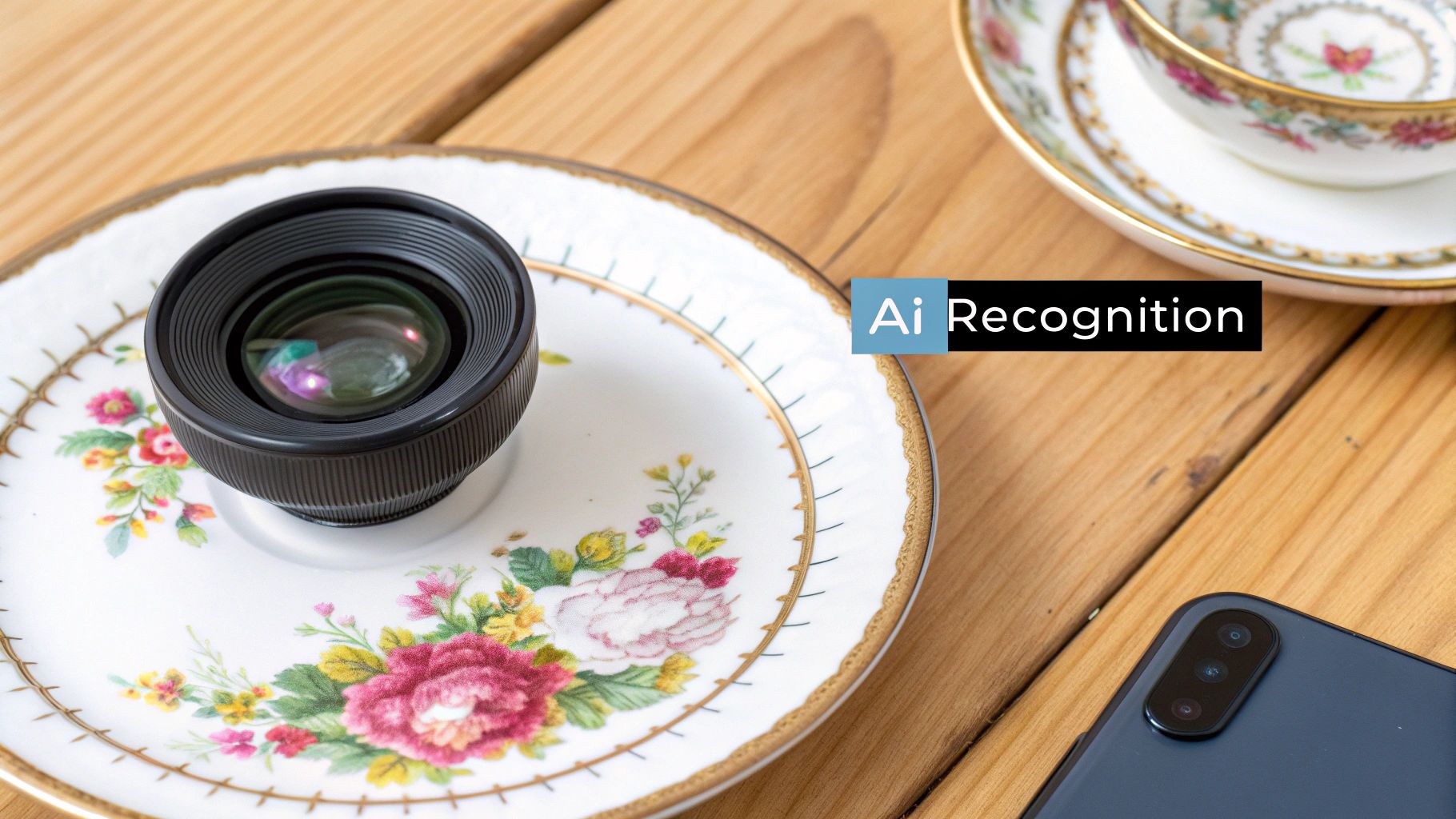
This entire system is designed to take the guesswork out of identification, giving you solid answers. So, let's pull back the curtain and see exactly how these apps figure out the story behind your stuff.
Step 1: Gathering the Clues
The whole investigation starts the second you take a picture. This first step is all about collecting evidence, and just like in a real investigation, the quality of that evidence is everything. The app can only work with what you show it, so clear, well-lit photos are an absolute must.
Think of it this way: you can't identify a suspect from a blurry security camera photo. The same goes for your antique. A fuzzy or dark picture hides the very details the app needs to see.
The app's accuracy is directly tied to how good your photos are. To get the best results, it helps to learn a few tricks for taking great shots, similar to what's covered in a professional product photography lighting setup.
Step 2: Analyzing the Evidence
Once your photo is uploaded, the app’s artificial intelligence (AI) gets to work. This is where a technology called computer vision kicks in. Essentially, computer vision lets the app “see” and understand your photo the way a seasoned expert would, only it does it in a fraction of a second.
The AI scans every single pixel, breaking down the image into thousands of tiny data points. It’s looking for specific visual clues that you or I might easily miss.
- Maker's Marks: The AI has been trained to recognize countless stamps, engravings, and labels from manufacturers all over the world. It can often spot a faint, worn-down mark that’s nearly invisible to the naked eye.
- Material and Texture: It looks at the visual cues of the material itself—the grain in a piece of wood, the specific glaze on porcelain, or the patina on a piece of metal—to help figure out its age and origin.
- Design and Pattern: The AI identifies stylistic elements, like the intricate carvings on a Victorian chair or the unique brushstrokes on a painting, placing the item in a specific time period or artistic movement.
- Construction Techniques: It can even detect tell-tale signs of how an item was made, like hand-cut dovetail joints on a drawer, which points to craftsmanship from before the age of mass production.
This deep dive creates a unique digital fingerprint for your item, getting it ready for the final step.
Step 3: Cross-Referencing the Database
With a detailed profile of your item built, the app now plays its final card. It compares that digital fingerprint against a massive database filled with millions of images and records of known antiques, collectibles, and artifacts.
This database is the app’s giant reference library. It pulls information from all over the place:
- Auction house records
- Museum catalogs
- Historical archives
- Online marketplace sales
- Expert appraiser contributions
The real power here is the app's ability to compare your one item against a world's worth of known examples in just a few seconds. That's a job that could take a human researcher weeks.
This is also where machine learning comes into play. Every time someone uses the app, the system gets a little bit smarter. It refines its patterns, learns to recognize new variations, and improves its accuracy with every single scan.
Finally, the app shows you the best matches from its database, often including historical context, where it might have come from, and sometimes even a potential value. Just like that, a simple photo unlocks the hidden story of your treasure.
What to Look For in a Great Antique ID App
With so many antique identification apps out there, it’s tough to know which ones are actually worth your time. Some are just glorified image search engines, while others are genuinely powerful tools for collectors. To cut through the noise, you need to know what features truly make a difference.
Think of it this way: a basic app might tell you what you have, but a great one tells you the whole story. It’s like having a historian, a market analyst, and a museum curator all in your pocket. These are the key features that combine to create that all-in-one expert experience.
A Massive and Well-Curated Database
At its core, every identification app relies on a database. This is the giant digital library the app’s AI scans to find a match for your photo. The bigger and more varied that library, the better the chances of getting an accurate hit. It’s the difference between asking a small-town librarian about a rare book and having the entire Library of Congress at your fingertips.
But it’s not just about size. The quality of the database is just as important. Some apps are generalists, covering everything from Victorian furniture to vintage toys. Others are specialists, focusing on niches like coins, pottery, or stamps. If you’re a die-hard collector of a specific category, an app with a specialized database will give you far more precise results because its AI is trained on exactly the right stuff.
Realistic, Data-Backed Valuations
Okay, you’ve identified your item. Now for the big question: what’s it worth? A top-notch app needs a solid valuation tool that gives you a realistic market estimate, not just a number pulled from thin air.
The best valuation engines are powered by a constant stream of real-world sales data. Look for apps that pull their numbers from:
- Major Auction Houses: Think Christie's or Sotheby's for high-end benchmarks.
- Online Marketplaces: Data from eBay, Etsy, and other antique-specific sites show what people are paying right now.
- Historical Sales Records: A deep archive of past sales reveals long-term value trends.
An app that shows you its work—by linking to recently sold items that are similar to yours—is one you can trust. That transparency lets you see the proof for yourself and gives you real confidence in the appraisal.
A great app doesn't just give you a price; it gives you the context behind that price. It empowers you to understand why an item is valued a certain way, turning a simple number into actionable knowledge.
Rich Historical Detail and Background
A good app tells you what you have and what it's worth. A great app tells you its story. This is where the real fun begins—the thrill of discovery that makes collecting so addictive. The best apps provide detailed historical context that connects your item to a specific person, place, or period.
This feature should answer the big questions:
- Who made this, and where?
- What design period is it from (e.g., Art Deco, Georgian, Mid-Century Modern)?
- What materials and techniques were used?
- What was its original purpose or cultural significance?
This is what turns a simple ID into a true learning experience. It helps you appreciate the history and craftsmanship behind your treasures and, ultimately, makes you a smarter collector.
A Lifeline to a Human Expert
Let’s be honest: AI is amazing, but it isn’t perfect. The most reliable apps understand this and offer a critical backup plan: access to human experts. It might be a premium feature, but for a potentially valuable or tricky item, it’s worth its weight in gold.
This "second opinion" service lets you send the AI's findings to a real, living appraiser or historian for confirmation. It closes the gap between an automated guess and a professional assessment, giving you total peace of mind. Knowing a human can double-check the results adds a layer of trust that’s essential when you’re deciding whether to sell, insure, or restore a cherished piece.
To help you weigh your options, here’s a quick-glance table breaking down the essential features you should be looking for.
Essential Features in an Antique Identification App
| Feature | What It Does | Why It Matters |
|---|---|---|
| Expansive Database | Cross-references your photo against millions of cataloged items. | A larger, more diverse library dramatically increases the odds of a correct match. |
| Data-Driven Valuation | Analyzes recent sales from auctions and online markets to estimate value. | Provides a realistic, evidence-based appraisal instead of a random guess. |
| Historical Context | Provides details on the item's origin, maker, period, and materials. | Transforms a simple ID into a rich learning experience and helps you spot fakes. |
| Human Expert Access | Allows you to submit AI findings to a professional for verification. | Offers a crucial "second opinion" for high-value items, ensuring maximum accuracy. |
| Community Features | Connects you with other collectors to share finds and ask questions. | Taps into the collective knowledge of fellow enthusiasts for tricky identifications. |
| Collection Management | Lets you catalog, organize, and track the value of your items over time. | Helps you build a digital inventory of your collection for insurance or personal records. |
When you're comparing apps, use this checklist. The more of these boxes an app ticks, the more likely it is to be a powerful and reliable tool for your collecting journey.
From Flea Market Find to Valued Treasure
It’s one thing to talk about features and tech specs, but what does using an antique identification app actually look like? Let's walk through a real-world story that shows just how powerful these tools can be. Meet Jane, a weekend flea market enthusiast who turned a dusty find into a genuine treasure, all with a little help from her phone.
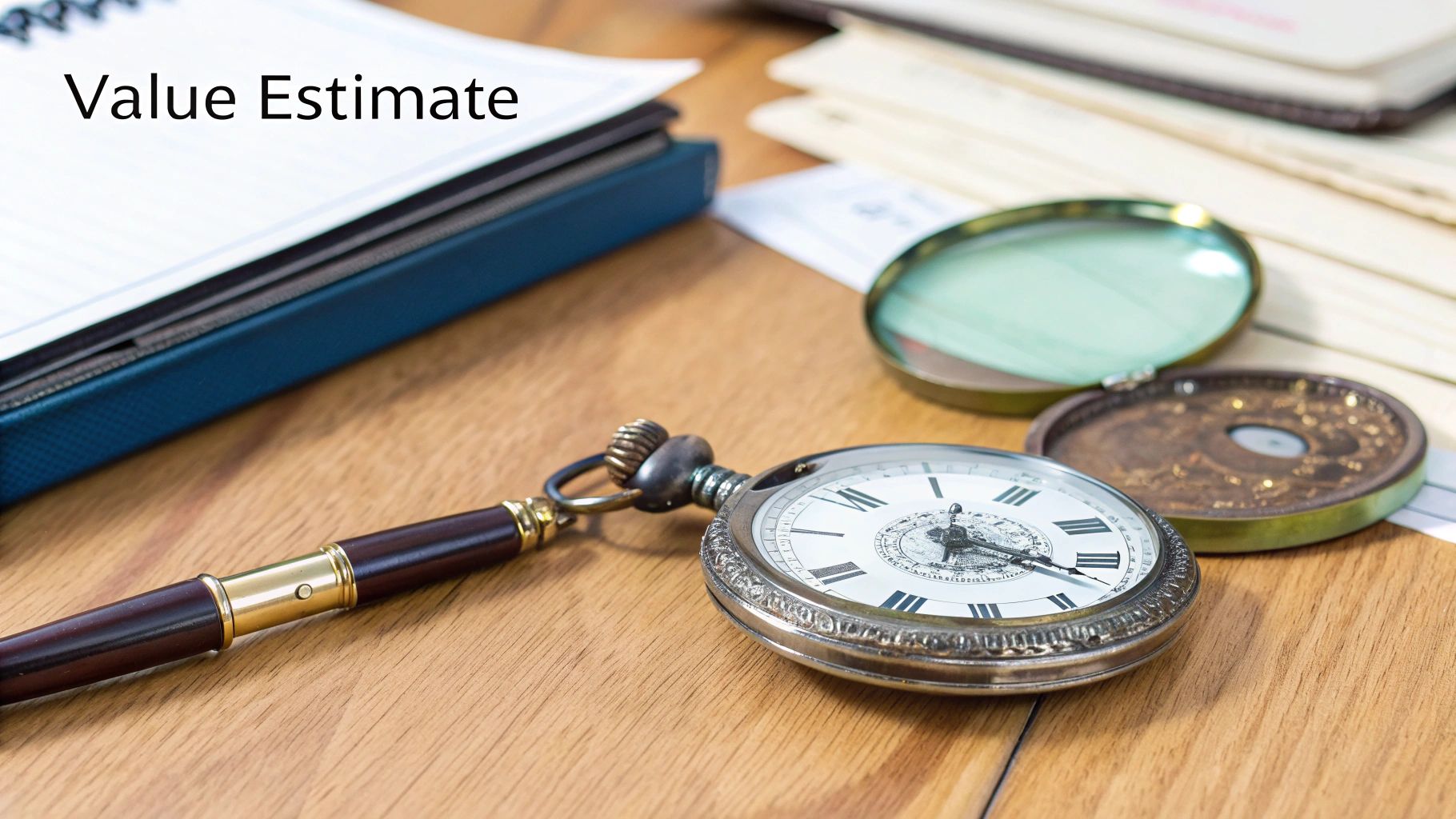
The story begins on a sunny Saturday morning. Jane was weaving through tables piled high with old furniture and forgotten odds and ends when a small, ornate vase caught her eye. It was tucked away behind a stack of books, covered in a thin layer of grime, but its elegant shape and hand-painted flowers stood out. The price? A mere $5. She wasn’t sure what it was, but she bought it on a whim.
The Moment of Discovery
Once she got it home and gave it a gentle cleaning, Jane spotted a faint, nearly invisible mark on the bottom. That little detail was all it took. Her curiosity sparked, she downloaded an antique identification app and started what felt like a mini-adventure.
The process itself was surprisingly simple. The app guided her to take a few specific photos:
- One clear shot of the entire vase.
- A couple of close-ups showing the painted details.
- Several pictures of that faint maker's mark, taken from different angles.
She uploaded the images, and the app’s AI immediately got to work, its gears turning as it scanned millions of items in its database. A moment later, the results popped up. Suddenly, Jane's casual $5 purchase had a real story to tell.
Unlocking a Hidden History
The app identified the vase as a piece of 19th-century European porcelain. But it didn't stop there. The report was filled with incredible details. That faint mark? It belonged to a small, well-regarded porcelain maker in Dresden, Germany, that operated from 1872 to 1918.
The app even gave her a brief history of the workshop, explaining that it was known for its delicate Rococo Revival style. It pulled up examples of similar pieces from museum archives and recent auction sales. What was just a dusty object a few hours earlier was now a direct link to the past—a piece of history she could actually hold.
The real magic of an antique identification app isn't just about the price tag. It's about the story it uncovers. It turns an ordinary object into a historical artifact, connecting a flea market find to a specific time, place, and creator.
Finally, the app gave her an estimated value. Based on recent sales of similar Dresden porcelain in good condition, it suggested a market value between $250 and $400.
This entire journey, from a curious purchase to a thrilling discovery, took less than ten minutes. Jane's story is a perfect example of how this technology puts expert knowledge right in your hands. The thrill is universal, whether you're looking at pottery, furniture, or something like identifying and valuing antique German currency.
While an app is an amazing first step, for potentially valuable items, you might want a second opinion. Checking out the 12 best antique appraisal online free services for 2025 is a great next move. Jane’s little adventure shows how anyone can start unlocking the secrets hidden in old objects.
The Journey from Dusty Books to AI Scans
Not so long ago, figuring out what you had on your hands was a real slog. Let's say you stumbled upon a curious old chair in your grandmother's attic. Your quest for its story would have started at the library, surrounded by towers of heavy, dusty reference books on furniture history. You’d spend hours, maybe even days, hunched over pages, trying to match the chair's carved legs or the way its joints were put together to a grainy illustration.
If the books didn't give you an answer, your next stop was a specialist. That meant tracking down a reputable appraiser, booking an appointment, and paying a hefty fee—all for one person's opinion. A quick answer was never guaranteed, and the expert you needed might be in another city or even another country, piling on more cost and complexity to your search. Honestly, this path was mostly for serious collectors with deep pockets and endless patience.
A New Era of Discovery
Then came the antique identification app, and it changed everything. Suddenly, the power of a massive reference library and a preliminary expert consultation was right in your pocket. The old roadblocks of time, cost, and access just vanished.
Instead of spending days at the library, you now spend a few seconds snapping a photo. The app's artificial intelligence (AI) instantly compares your item against millions of data points from auction records, museum catalogs, and historical archives. What once required a formal visit to an expert now happens in your living room, opening up a world of knowledge that used to be locked away.
This shift is about more than just convenience; it's a fundamental change in how we connect with history. An antique identification app sparks curiosity, turning a simple "what is this?" into an immediate and fascinating journey of discovery for anyone.
Looking back, this move to AI is a massive leap from the old appraisal methods. By 2025, apps armed with AI image recognition have put expert-level insights into the hands of amateurs and pros alike, giving you everything from a quick ID to a detailed historical report. This technology has also brought a new level of transparency to the antiques trade, helping to cut down on fakes and forgeries by blending centuries-old tradition with 21st-century tools. You can explore how these apps are reshaping the market with powerful digital technology.
The Broader Impact of AI
The AI in an antique app is just one piece of a much bigger puzzle. As this technology gets better at analyzing historical artifacts with stunning accuracy, it’s mirroring breakthroughs happening in all sorts of other fields. The same fundamental tech helps power everything from medical diagnostics to the personalized shopping suggestions you see online.
This really shows a wider trend of AI being woven into every part of our lives. To learn more about the broader capabilities and applications of AI, it’s worth thinking about how this technology is popping up in places you'd never expect. The journey from dusty books to AI scans isn't just about antiques; it's about making specialized knowledge available to everyone.
How to Choose the Right App for Your Needs
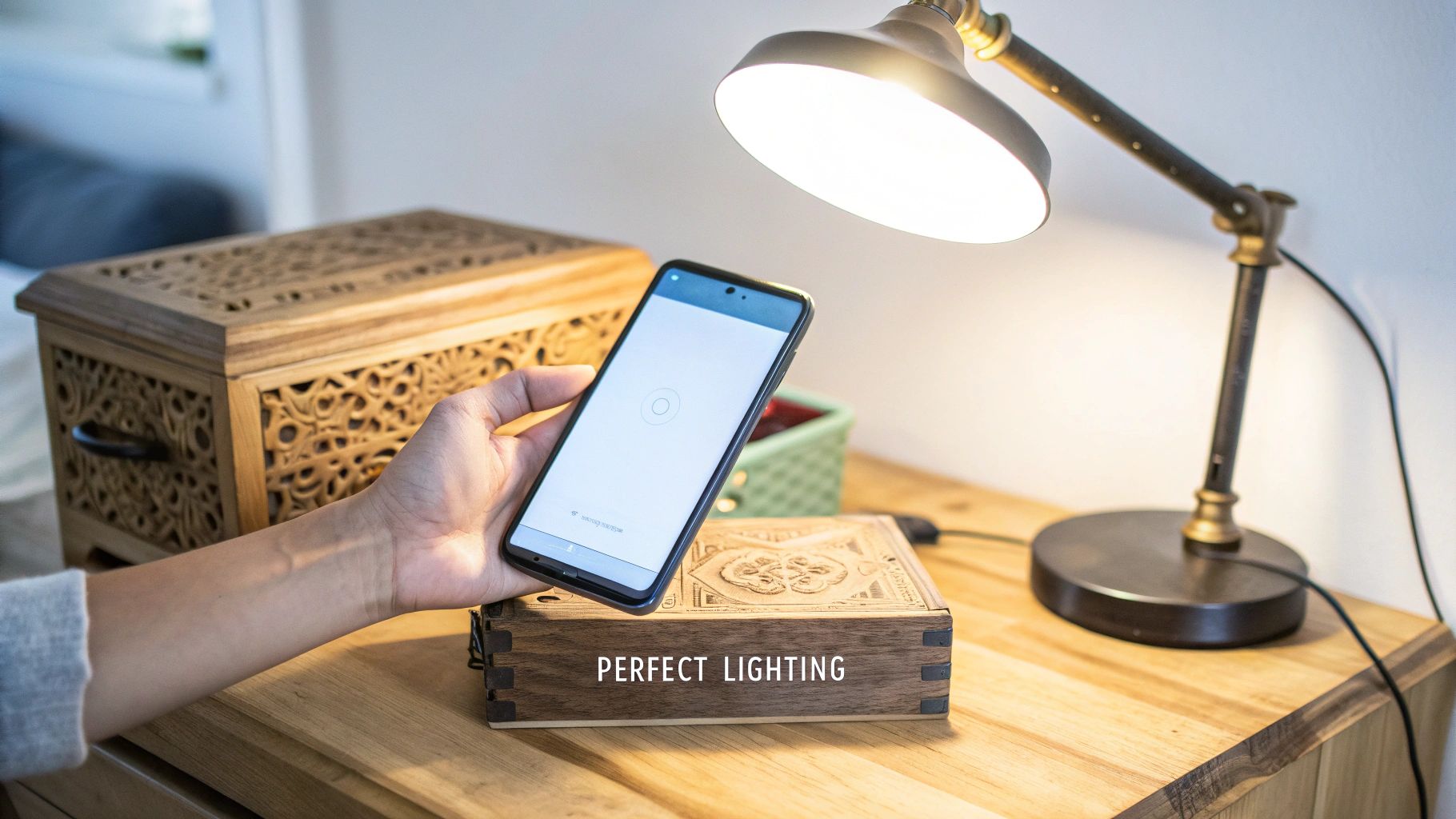
With more and more of these apps popping up, picking the right one can feel a bit like hunting for a needle in a haystack. The perfect tool for a professional reseller probably isn't the best fit for a weekend hobbyist. To find the app that actually works for you, it helps to know what you’re looking for.
Think of it like buying a car. You wouldn't get a two-seater sports car to haul lumber, right? In the same way, the best app depends entirely on what you want to identify and what you’ll do with that information.
First, Look at the App’s Specialty
The very first thing to check is the app’s database. Is it a jack-of-all-trades, trying to identify everything from Victorian furniture to vintage brooches? Or does it focus on a specific niche, like coins, stamps, or pottery?
A specialized app will almost always give you more accurate and detailed results for its particular category.
Before you download anything, ask yourself a couple of quick questions:
- What kinds of things do I usually look up? If you’re constantly trying to identify old ceramics, an app with a deep pottery database is non-negotiable.
- Does this app's focus match my collection? A quick scan of the app’s description and reviews should tell you if other people are having success with your kind of items.
Just answering these will narrow down the field in a big way, saving you from wasting time on a tool that's just not built for your needs.
Next, Check Out the Price Tag and User Reviews
Once you’ve found a few promising options, it’s time to look at the cost. Most of these apps use one of three models: free (but with ads), a monthly or yearly subscription, or a pay-per-scan model. A free version is a great way to kick the tires, but for serious use, a subscription often unlocks better features and more reliable results.
This is where user reviews become your best friend. Don't just glance at the star rating—dig into what people are actually saying. Look for comments on accuracy, how helpful customer support is, and how often the app gets updated. Frequent updates are a fantastic sign that the developers are actively improving it.
An antique identification app is an investment. You're either investing your time with a free version or your money with a paid one. User reviews give you a real-world preview of the return you can expect.
The demand for these tools is growing fast. One app, for example, saw over 9,000 installs in less than a year. This shows a huge market of collectors and enthusiasts who are willing to pay for quality tools.
Finally, Know the Limits and Be Realistic
It's important to remember that even the smartest AI isn't perfect. An app is an incredible starting point—it gives you a data-backed best guess about an item's history and potential value.
But it’s not a replacement for a certified human appraiser, especially when you think you might have something really valuable. A great app points you in the right direction and tells you when it’s time to get a professional opinion. To get a better handle on this, our guide on figuring out what your antique is worth offers some great context.
By weighing an app's specialty, cost, and user feedback, you can find a powerful tool that turns your thrift store curiosity into real, actionable knowledge.
Got Questions? We've Got Answers
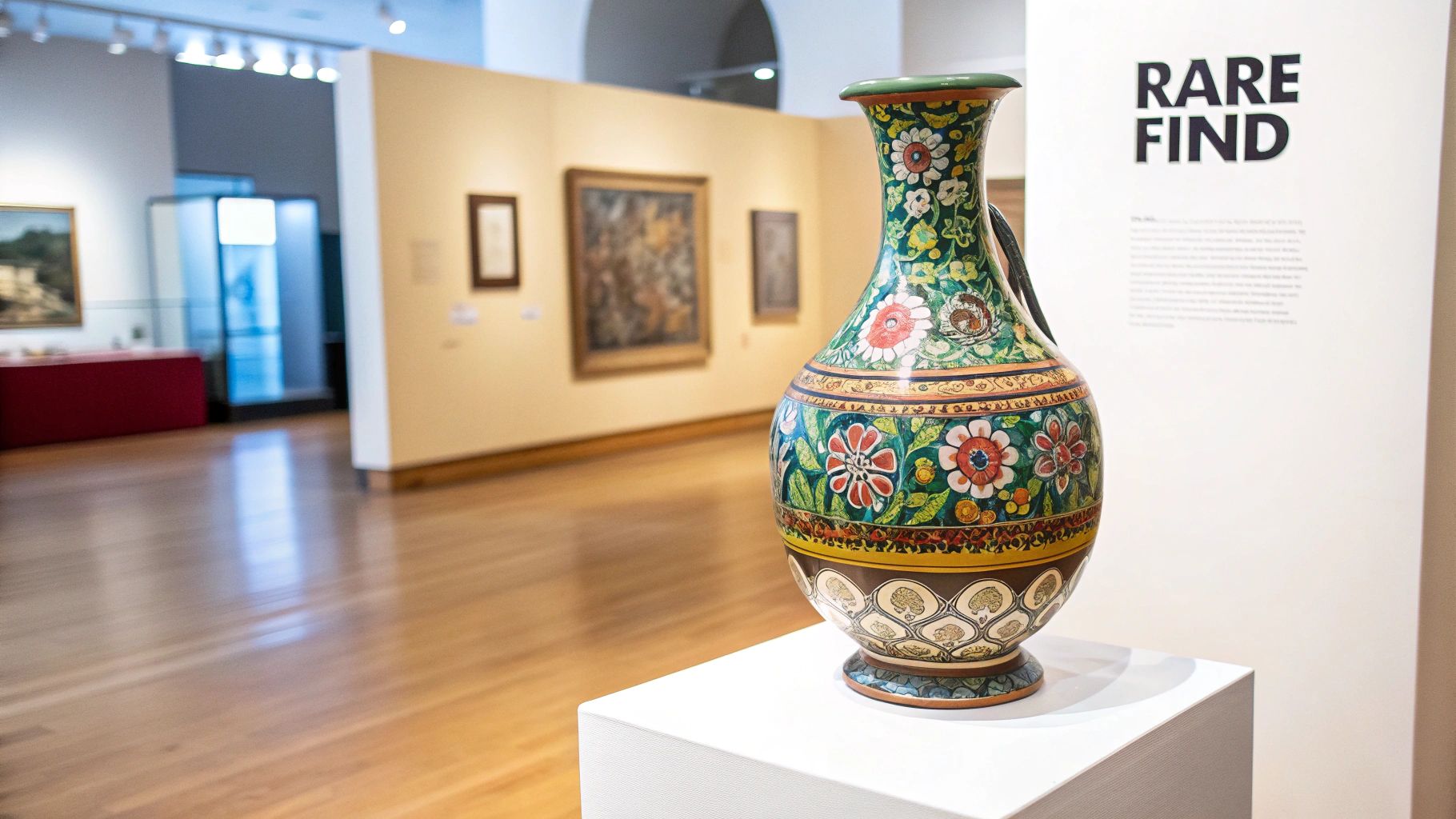
It's totally normal to have a few questions before you start pointing your phone at every old thing in your house. These apps are incredible tools, but knowing what they can—and can't—do is the key to getting the most out of them. Let's tackle some of the most common questions we hear.
Think of this as your friendly cheat sheet. It’s here to clear up any confusion and get you ready to start identifying your finds with confidence.
Just How Accurate Are the Valuations?
This is the big one, isn't it? The best way to think about app valuations is as well-informed estimates, not gospel. The technology scans a massive amount of recent sales data from auction sites, online marketplaces, and dealer listings to give you a realistic price range for what your item is currently fetching.
A few things really influence the accuracy:
- Your Photos: The clearer your pictures, the better the AI can see what it's working with. Good lighting is your best friend here.
- How Rare It Is: For a common piece of Fiestaware, there's tons of sales data, so the estimate will be pretty tight. For a one-of-a-kind folk art carving? Much less so.
- The App's Database: A bigger, constantly growing database means the app has more information to draw from, which leads to better results.
For casual curiosity, pricing items for a yard sale, or getting a ballpark figure for insurance, these app valuations are fantastic. If you think you've found a true masterpiece, use the app's estimate as your starting point before calling in a human expert.
Can This App Replace a Professional Appraiser?
Honestly? No, and any good app will tell you that. An antique identification app is your first-opinion tool. It’s like having an antique-savvy friend in your pocket who can give you instant feedback and help you figure out if something is special.
A professional appraiser offers a certified, legally recognized valuation after a physical inspection, deep research into its history, and years of hands-on experience. An app gives you an immediate, AI-powered estimate to help you decide what to do next.
The app is the perfect first step. It lets you quickly sort the treasures from the trinkets and decide which items are actually worth the time and money for a formal appraisal. The real magic happens when you combine the speed of technology with the depth of human expertise.
What Happens to My Photos After I Upload Them?
Your privacy is a big deal, and reputable apps know it. When you upload a picture, it's sent to a secure server where the AI does its thing. That image is only used to identify your item. It isn't sold or splashed across the internet.
Most platforms will anonymize your photo and use it to help train the AI, making the system smarter for everyone without ever connecting it back to you. It's always a good idea to glance at the app's privacy policy, but protecting your photos and data is the standard.
Ready to finally find out what that old vase from grandma is worth? With Curio, you can identify antiques, uncover their history, and get a real-world valuation in seconds.
Download Curio today and let your antiques tell their story!
